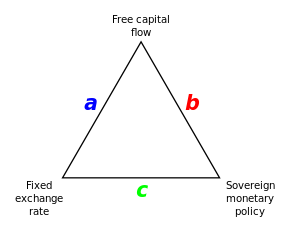
The impossible trinity (also known as the impossible trilemma, the monetary trilemma or the Unholy Trinity) is a concept in international economics and international political economy which states that it is impossible to have all three of the following at the same time:
- a fixed foreign exchange rate
- free capital movement (absence of capital controls)
- an independent monetary policy
It is both a hypothesis based on the uncovered interest rate parity condition, and a finding from empirical studies where governments that have tried to simultaneously pursue all three goals have failed. The concept was developed independently by both John Marcus Fleming in 1962 and Robert Alexander Mundell in different articles between 1960 and 1963.[1]
Historically in advanced economies, the periods pre-1914 and 1970–2014 were characterized by stable foreign exchange rates and free capital movement, whereas monetary autonomy was limited. The periods 1914–1924 and 1950–1969 had restrictions on capital movement (e.g. capital controls), but exchange rate stability and monetary autonomy were present.[2][3]
- ^ Boughton, James M. (2003). "On the Origins of the Fleming-Mundell Model" (PDF). IMF Staff Papers. 50 (1): 1–3. doi:10.5089/9781451852998.001. Retrieved 17 April 2019.
- ^ Eichengreen, Barry; Esteves, Rui Pedro (2021), Fukao, Kyoji; Broadberry, Stephen (eds.), "International Finance", The Cambridge Economic History of the Modern World: Volume 2: 1870 to the Present, vol. 2, Cambridge University Press, pp. 501–525, ISBN 978-1-107-15948-8
- ^ Broz, J. Lawrence; Frieden, Jeffry A. (2001). "The Political Economy of International Monetary Relations"". Annual Review of Political Science. 4 (1): 317–343. doi:10.1146/annurev.polisci.4.1.317. ISSN 1094-2939.